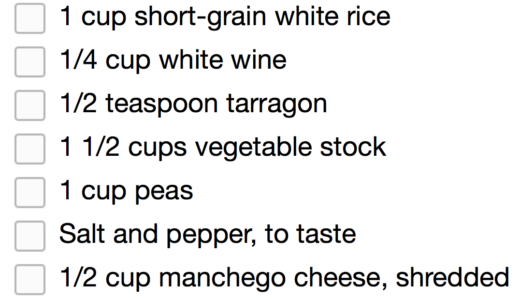Cooking with cups
I enjoy cooking. So the plan to invite some friends for dinner, as they are moving house and are, hence, in total disarray, was fine with me. They are vegetarians. Although I am a meat eater, I do not demand meat with every meal, so I am happy to accommodate other people’s preferences. I looked up my file of recipes [in Evernote], where I had tagged all the vegi ones and decided to make “Spring Paella with Peas, Asparagus and Manchego Cheese”. I have a goal to try at least one new recipe each month this year and this is the second one in May!
Perusing the recipe, I notice that it is American [I do not necessarily record the source of my filed recipes]. This is OK, so long as I can identify/get the ingredients, but it brings other challenges …
Here is part of the ingredients list for my recipe:
All the items are quite straightforward, but I am very challenged by the measurements. Like all American recipes, everything is in cups! In Europe, we tend to measure liquids by volume [which mostly equates to a weight] and solid goods by weight. The only exception is very small quantities, where we also use teaspoon or tablespoon for both.
I know that a cup is approximately 250ml, so the wine and stock are easy – 62.5ml and 375ml respectively. But what about the rice and the peas? I pour the stuff into my measure up the 250ml mark. Should I stop there? If I lightly tap the container, the ingredient settles a bit and I need to add some more to get to 250ml. When do I stop? If I am weighing stuff, 250g is 250g – there is no room for uncertainty.
If those were not hard enough, what about the cheese? Cheese is sold by weight everywhere. You either ask for a weight or the package tells you the weight that it contains. So, what do you buy to get half a cup? My first thought was that this is 125ml and milliliters are the same as cubic centimeters, so I just need a 125cc block of cheese – say 3cm x 4cm x 10.5cm. But that is not right, as shredded [I would say “grated”] cheese is less dense, so takes up more space. In the end, I just grated all the Manchego that I had to hand and it looked like at least half a cup.
The good news is that the dish turned out very well and was all consumed, with the guests having second helpings.
Any American cooks who can give me advice? Please comment or contact me via email or social media. Bon Appétit, as we say in England.
Comments
Leave a Reply
You must be logged in to post a comment.

Like most things you grow up with, you rarely question them until someone outside your sphere asks Why?
I am just sous chef in our house and run into the cheese problem often, the problem is exacerbated by Chef not following the recipe(requirements).
For cooking, I am not bothered by dry ingredient inaccuracies, baking I believe is another matter.
Thanks for a break from work-related reading.
@KeithM – You are quite correct in that, for most cooking, but maybe not baking, precision is not essential. I have enough cooking experience to make good guesses. But, on the other hand, I like precision when it is not overly hard to implement.
Wow! What a great article. Going through your post I have learned a lot of excellent info about COOKING MEASUREMENTS.
I have measurements related post and its help to how many teaspoons make a tablespoon, Check it out for more detailed information.